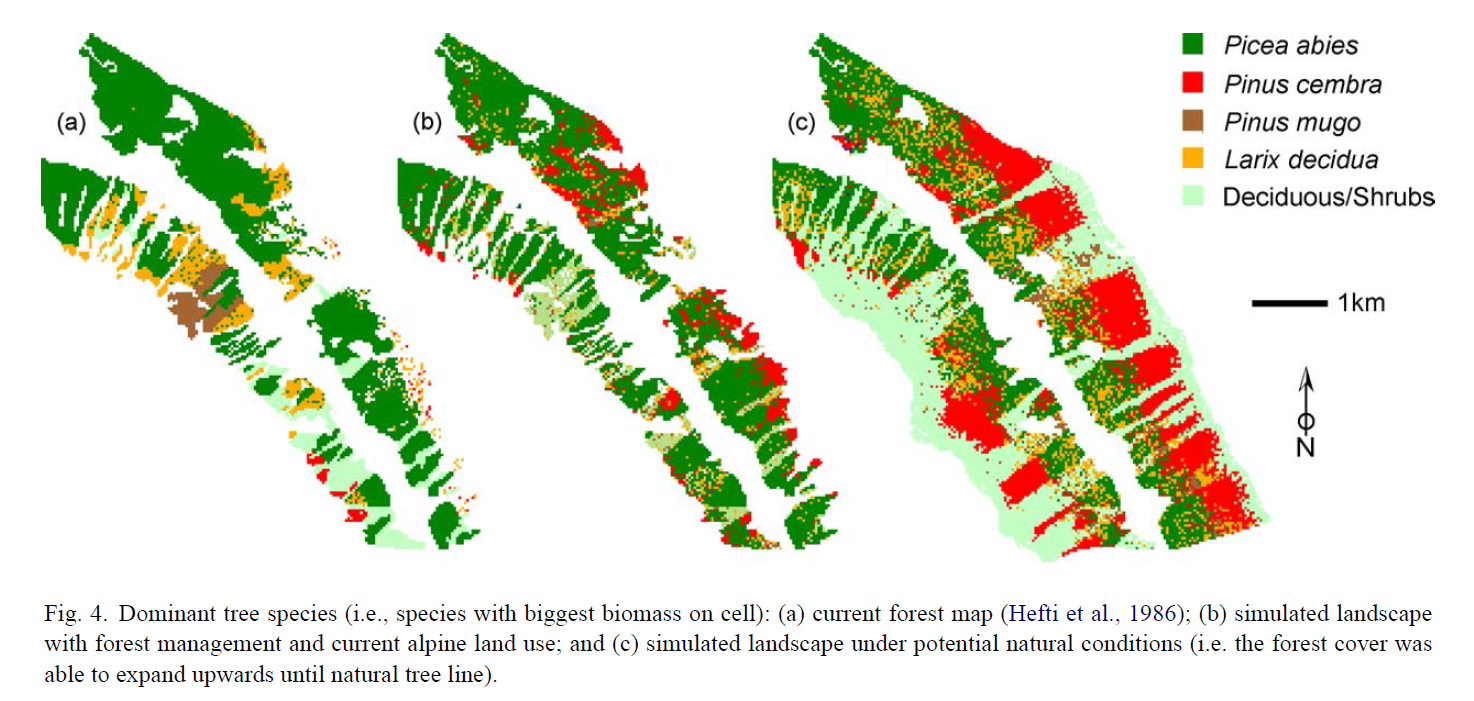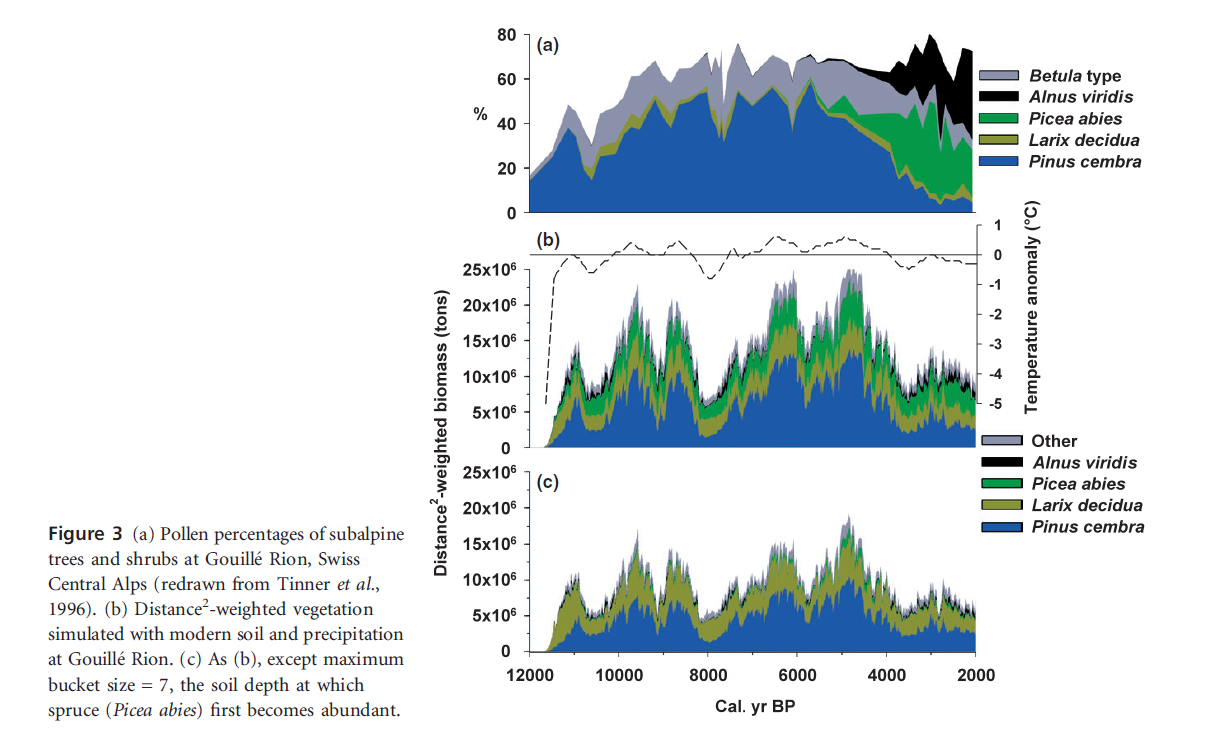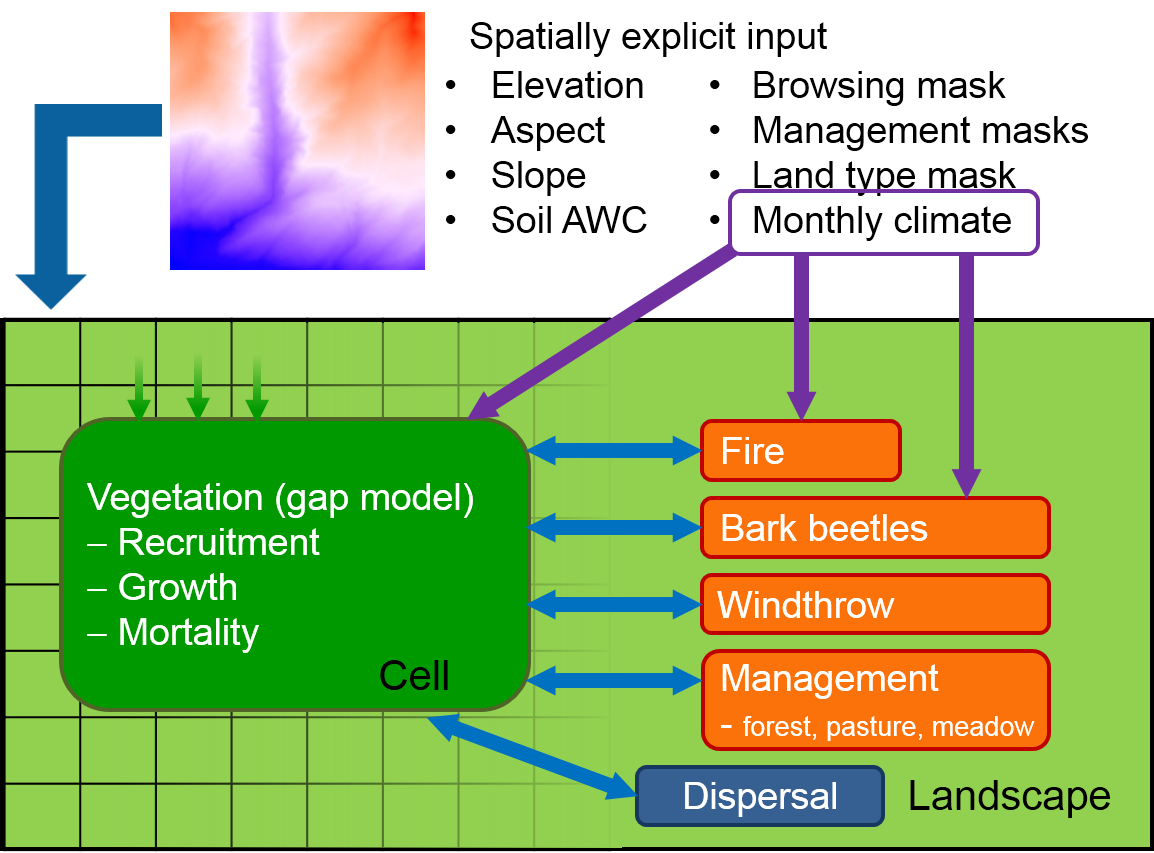Select one of the following links to be guided to specific chapters:
Overview
LandClim is a stochastic process-based model designed to study spatially explicit forest dynamics at the landscape scale over long time periods with a fine spatial resolution.
The model is a descendant of the raster-based LANDIS model (Mladenoff, 2004) with an improved tree growth and succession sub-model. The tree growth (‘stand scale’) processes are based on a simplified version of the forest gap model FORCLIM (Bugmann, 1994), in order to maintain computational efficiency at the larger scale. The model has been used to predict historic (Colombaroli et al., 2010, Henne et al., 2011), current (Schumacher et al., 2004) and future forest dynamics (Elkin et al., 2013, Temperli et al., 2013) in various parts of the world such as Central Europe (Briner et al., 2013), USA (Schumacher et al., 2006) or New Zealand (Thrippleton et al., 2014).
Structure of the model
The design of LandClim reflects processes at two spatial scales: (1) the stand scale (with grid cells of 25m x 25 m) and (2) the landscape scale (large geographical areas up to several thousand hectares).
At the stand scale, the model simulates tree growth, recruitment and mortality within each grid cell, using species-specific life history parameters. The model uses a cohort approach; i.e., trees of the same age and species are simulated by one representative individual.
At the landscape scale, LandClim simulates processes that occur across grid cells, including seed dispersal, disturbances and forest management regimes (Temperli et al., 2013, Schumacher and Bugmann, 2006). Presently four disturbance types are implemented: fire, windthrow, bark beetle outbreaks and browsing pressure.
Model applications
A selection of the most significant publications concerning the application of LandClim:
Improving the formulation of tree growth and succession in a spatially explicit landscape modelIntegration of a simple tree succession sub-model in LANDIS, which incorporates quantitative descriptions of forest structure, and including sub-models to capture the influences of competition as well as climatic and edaphic parameters on tree population dynamics. The new model LandClim was tested for managed as well as unmanaged conditions in the Dischma valley (Switzerland) and accurately predicted the altitudinal distribution of vegetation properties as well as vegetation recovery following wind disturbance events.

Schumacher et al. (2004); Ecological Modelling 180; 175–194
Previous studies of climate change impacts on forests have mainly focused on direct effects of climate. In the present study, we applied LandClim to two case study landscapes in the European Alps and assessed the interactions among forest dynamics, climate change and large-scale disturbances such as fire, wind and forest management. The simulations revealed that projected future climate change would cause extensive forest cover changes. Fire is likely to become almost as important for shaping the landscape as the direct effects of climate change.

Schumacher and Bugmann (2006); Global Change Biology 12; 1435–1450
Palaeobotanical studies have demonstrated that forests reacted highly sensitive to climate change during the Holocene. However, temperature alone cannot account for important changes in tree species abundance. We examined the impact of reduced moisture availability on forest dynamics using a combined dynamic modelling/palaeoecological approach at two high-elevational lakes in the Swiss Central Alps. Our simulation results suggest that Spruce expanded in the Central Alps only after soils developed sufficient water-holding capacity and precipitation neared its modern abundance.

Henne et al. (2011); Journal of Biogeography; 38; 933–949
We focused on mountain forests in the European Alps and evaluated how a range of ecosystem services (ES) are projected to be impacted in a 2 °C warmer world, using four novel regional climate scenarios. Our results suggest that the sensitivity of mountain forest ES to a 2 °C warmer world depends heavily on the current climatic conditions of a region, the strong elevation gradients within a region, and the specific ES in question. Although our results indicate a heterogeneous response of mountain forest ES to climate change, the projected substantial reduction of some forest ES in dry regions suggests that a 2 °C increase in global mean temperature cannot be seen as a universally ‘safe’ boundary for the maintenance of mountain forest ES.

Elkin et al. (2013); Global Change Biology 19; 1827–1840
Bark beetles are a key forest disturbance agent worldwide, with their impact shaped by climate, forest susceptibility, and interactions with other disturbances such as windthrow and fire. We developed a spatially explicit model of European spruce bark beetle (Ips typographus) dynamics that incorporates beetle phenology and forest susceptibility and integrated it in LandClim. We used this model to examine the mechanisms and feedbacks that are driving short-term and long-term interactions among beetle disturbance, climate change, and windthrow, and how they may shift in the future. Our results suggest that, depending on initial environmental conditions, climate change may shift the importance of direct and indirect drivers of disturbances. These shifts may affect the sign and strength of cross-scale disturbance interactions and may impact the cost-benefit trade-off between beetle suppression and preventive management strategies.

Temperli et al. (2013); Ecological Monographs; 83(3); 383–402
The Mediterranean Basin is the region of Europe most vulnerable to negative climate-change impacts, including forest decline, increased wildfire, and biodiversity loss. Because humans have affected Mediterranean ecosystems for millennia, it is unclear whether the region’s native ecosystems were more resilient to climate change than current ecosystems, and whether they would provide sustainable management options if restored. We simulated vegetation dynamics with LandClim, using present-day climate as well as future climate-change scenarios, in three representative areas that encompass a broad range of Mediterranean conditions and vegetation types. When combined with modeling, paleoecological evidence reveals the potential of native vegetation to re-establish under current and future climate conditions, and provides a template for novel management strategies to maintain forest productivity and biodiversity in a warmer and drier future.

Henne et al. (2015); Front Ecol Environ 13(7); 356–362
Model history
Development of the forest landscape model LandClim, test of its realism compared to vegetation data from the Dischma valley, European Central Alps as well as the Colorado Front Range, USA.
Main reference:
- Schumacher et al. (2004), Ecological Modelling 180, 175–194
- Schumacher et al. (2006), Landscape Ecology 21, 539–554
Technical information
The LandClim source code is maintained in C#.
LandClim runs on Windows, Mac OS X and Linux operating systems.
LandClim is provided as an executable file together with a set of xml-files where all the basic settings of the simulation experiment and model parameters are managed.
References:
HENNE, P. D., ELKIN, C., FRANKE, J., COLOMBAROLI, D., CALÒ, C., LA MANTIA, T., PASTA, S., CONEDERA, M., DERMODY, O. & TINNER, W. (2015). "Reviving extinct Mediterranean forest communities may improve ecosystem potential in a warmer future" Frontiers in Ecology and the Environment, 13: 356-362.
THRIPPLETON, T., DOLOS, K., PERRY, G. L. W., GROENEVELD, J. & REINEKING, B. (2014). "Simulating long-term vegetation dynamics using a forest landscape model: the post-Taupo succession on Mt Hauhungatahi, North Island, New Zealand" New Zealand Journal of Ecology, 38: 26-38.
BRINER, S., HUBER, R., BEBI, P., ELKIN, C., SCHMATZ, D. R. & GRÊT-REGAMEY, A. . (2013). "Trade-Offs between Ecosystem Services in a Mountain Region" Ecology and Society, 18: 35.
ELKIN, C., GUTIÉRREZ, A. G., LEUZINGER, S., MANUSCH, C., TEMPERLI, C., RASCHE, L. & BUGMANN, H. (2013). "A 2 °C warmer world is not safe for ecosystem services in the European Alps" Global Change Biology, 19: 1827-1840.
TEMPERLI, C., BUGMANN, H. & ELKIN, C. (2013). "Cross-scale interactions among bark beetles, climate change, and wind disturbances: a landscape modeling approach" Ecological Monographs, 83: 383-402.
HENNE, P. D., ELKIN, C. M., REINEKING, B., BUGMANN, H. & TINNER, W. (2011). "Did soil development limit spruce (Picea abies) expansion in the Central Alps during the Holocene? Testing a palaeobotanical hypothesis with a dynamic landscape model" Journal of Biogeography, 38: 933-949.
COLOMBAROLI, D., HENNE, P. D., KALTENRIEDER, P., GOBET, E. & TINNER, W. (2010). "Species responses to fire, climate and human impact at tree line in the Alps as evidenced by palaeo-environmental records and a dynamic simulation model" Journal of Ecology, 98: 1346-1357.
SCHUMACHER, S. AND H. BUGMANN. (2006). "The relative importance of climatic effects, wildfires and management for future forest landscape dynamics in the Swiss Alps" Global Change Biology 12: 1435-1450.
SCHUMACHER, S., B. REINEKING, J. SIBOLD, AND H. BUGMANN. (2006). "Modeling the impact of climate and vegetation on fire regimes in mountain landscapes" Landscape Ecology 21: 539-554.
MLADENOFF, D. J. (2004). "LANDIS and forest landscape models" Ecological Modelling, 180: 7-19.
SCHUMACHER, S., H. BUGMANN, AND D. J. MLADENOFF. (2004). "Improving the formulation of tree growth and succession in a spatially explicit landscape model" Ecological Modelling 180: 175-194.
BUGMANN, H. (1994). "On the ecology of mountainous forests in a changing climate: a simulation study" Ph.D. Dissertation, ETH Zurich
